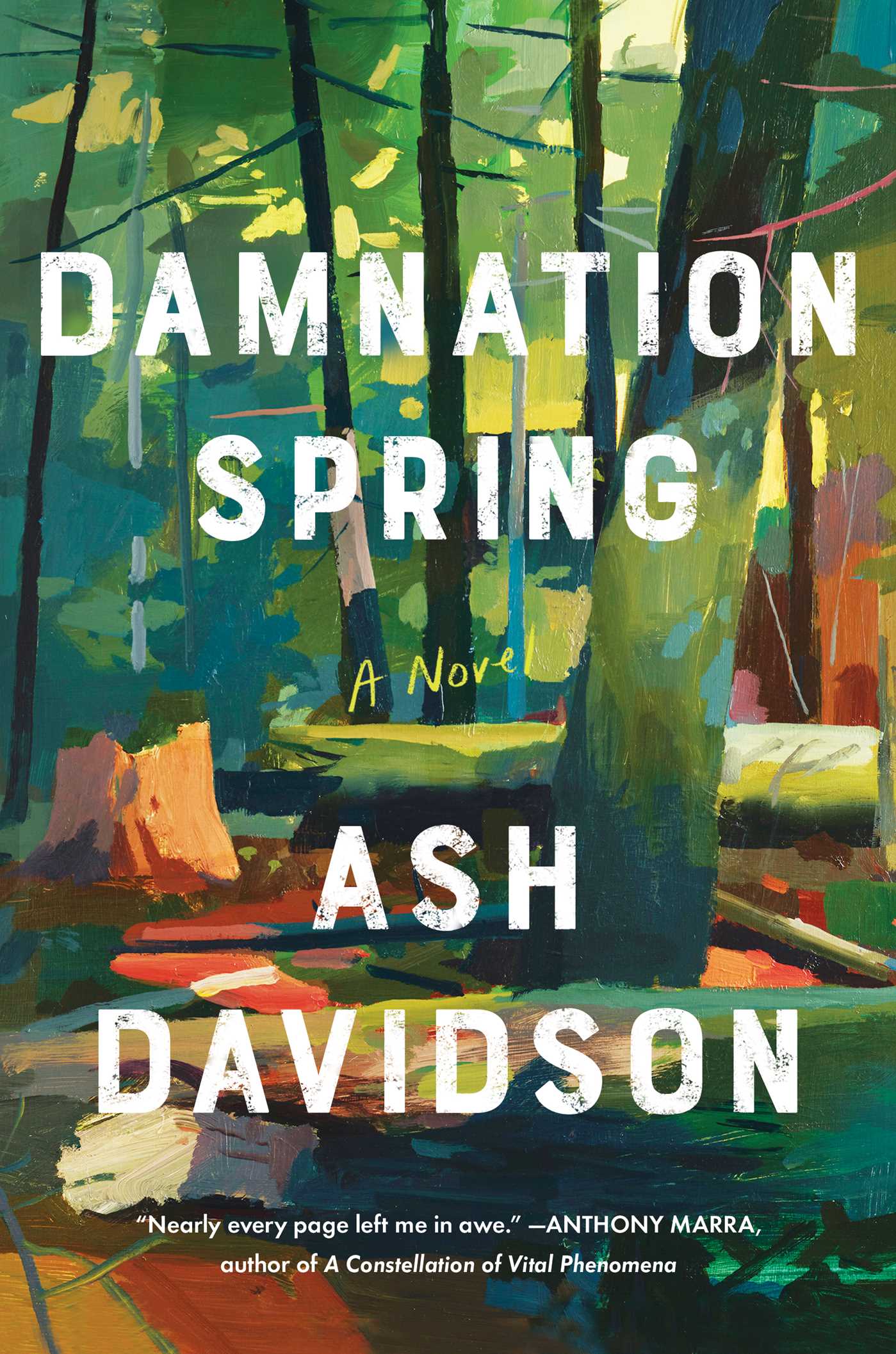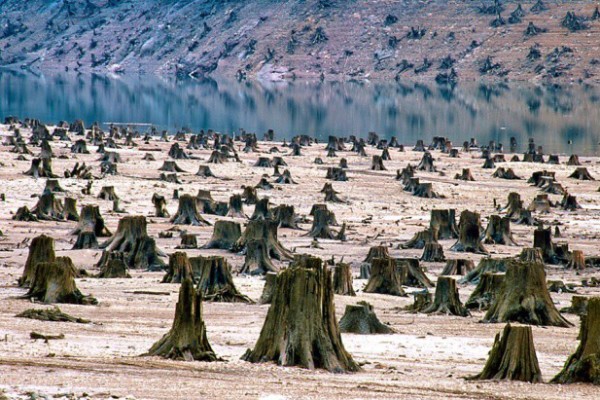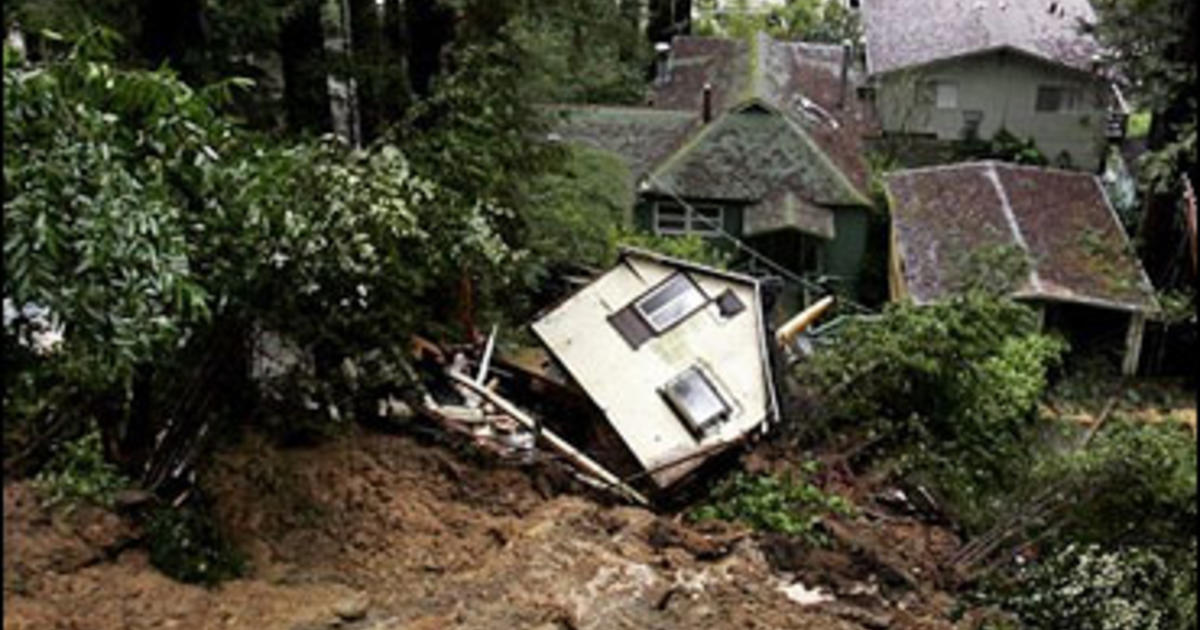
He pictured the 24-7 tree herself: a monster, grown even wider now than the twenty-four feet, seven inches that originally earned her the name, three hundred seventy feet high, the tallest of the scruff of old-growth redwoods left along the top of 24-7 Ridge. He’d circled that tree every morning for the last thirty-five years, figuring the best way to fall her, but it had always been just a story he’d told himself, like his father before him, and his granddad before that. Someday, Rich remembered his father saying. As a boy, it had seemed possible, though generations of Gundersens had died with the word on their breath.
“The real timber’s gone,” Lark said. “What’s left, ten percent, including the parks? Two thousand years to grow a forest, a hundred years to fall it. No plague like man.”
It’s 1977 in Klamath, California. Redwood country. Rich Gunderson has rolled the dice. He staked all the money he and his wife, Colleen, have been saving to buy a once-in-a-lifetime piece of property, the 24-7, over seven hundred acres of old growth forest, ripe for logging. But he needs the Sanderson Timber Co., which he has been working for all his life, to build a road close enough to it that he can get the logs out. It seems likely to happen, given that Sanderson is currently logging adjacent parcels. But when a skull is found, all work is halted until it can be determined whether the logging will be allowed to continue. A halt could mean the difference between making back his investment and having land of his own, a place on which he and his family can live, with a nice bit of cash beside, and losing everything.
The pilot had followed the coastline, turning inland at Diving Board Rock. It was Rich’s first and only ¬bird’s-eye view of his life: the small green house with its white shutters set back on the bluff at the foot of Bald Hill, the cedar-¬shingle tank shed. The plane’s ¬engine noise buzzed inside his chest, a hundred McCulloch chainsaws revving at once. They’d flown over 24-7 Ridge, the big tree herself lit by an errant ray of sun, glowing orange, bright as a torch, and, for an instant, Rich had caught a glimmer of the inholding’s potential—an island of private land in a sea of company forest. They’d flown over the dark waves of big pumpkins in Damnation Grove—redwoods older than the United States of America, saplings when Christ was born. Then came the patchwork of clear-cuts, like mange on a dog, timber felled and bucked and debarked, trucked to the mill, sawed into lumber, sent off to the kilns to be dried. The pilot had flipped a switch and spray had drifted out behind them in a long pennant—taste of chlorine, whiff of diesel—Rich’s heart soaring.

Ash Davidson – Image from the Grand Canyon Trust
He and Colleen have suffered some serious losses already. They have a five-year-old son, Chub, who is about to start Kindergarten. But they had hoped for a larger brood. Colleen, only thirty-four, has just suffered her eighth miscarriage. Rich does not want for them to go through that again, so is keeping his distance, frustrating Colleen, who is eager to keep trying.
He does not keep his distance from this land, however. Carrying on the tradition of his father and grandfather before him, Rich is a high climber, a particularly perilous specialty in an already dangerous line of work. He is very fortunate to have lasted longer than his forebears, surviving into his fifties. Bunyonesque at over six feet six inches, Rich is a gentle giant, determined to take care of his family. But how he can go about doing that is becoming complicated. He remembers his father taking him up to the 24-7, and pointing out the biggest, (There she is. Twenty-four feet, seven inches across. Someday, you and me are going to fall that tree.) a lifetime ago, when his father had just turned thirty.
A high rigger – using just his rope and spiked boots, he must climb the tree sawing off tree limbs as he goes – image and descriptive text from the Washington Historical Society
Colleen works as a midwife. Hers are not the only reproductive anomalies in the area. Miscarriages are rampant, as are birth defects. One woman she had been helping gave birth to a baby that was anencephalic. In the Library Journal interview, Davidson talks about her inspiration for the book.
My family lived in Klamath, California, where the book is set. My parents weren’t loggers—my mom taught school, my dad did carpentry work. But they did rely on a nearby creek for drinking water, similar to Rich and Colleen’s setup in the book, and became so concerned about herbicide contamination in that creek that they stopped drinking from our tap. Still today, not one of us does. I was three when we left Klamath, but I grew up hearing stories about our life there. I’d always wondered: what were those herbicides? – from the Shelf Awareness interview
Daniel Bywater was raised locally. An erstwhile classmate and an old flame of Colleen’s, he is back in the area, doing a postdoc in fisheries biology, testing the water to see what might be causing the significant reduction in fish life. It is pretty clear that the cause is the toxic chemicals that Sanderson sprays relentlessly in the area, making sure the logging roads do not get overgrown, and access to the to-be-logged trees is uninhibited. With the prompt of Daniel, Colleen begins to see that the environment in which she lives may be a factor in her difficulties carrying a baby to term. The Gundersons get their water directly from Damnation Creek.

Redwoods – image from homestratosphere.com
The conflict is set. Sanderson, eager to fend off any attempts to prevent them from clear-cutting the lands they control, versus those concerned with the health and safety of the people living and working in the area, and the carnage being wreaked on the local eco-system. The company is not above using bribery, blackballing, physical intimidation, and worse to control the allowable debate.
People are struggling. Deer Creek has dried up. It is probably wise to head indoors when the far-too-frequent company chopper passes overhead spraying something that smells of chlorine. Folks live in single-wides or rent houses they used to own, now property of the government on a 25 year lease, after they were eminent-domained for parkland. Pay has been shifted from production based to a daily rate. Not an idyllic existence
It would be an easy thing to present the company as pure evil (well, it pretty much is here, so scratch that), and the locals who support cutting-uber-alles as ignorant rubes. Some are, and there are those who are willfully ignorant, and willing to go to dark extremes to protect their personal fortunes, but Davidson has offered instead a very close look at the crux of the conflict. Can you really expect people who, for generations, have known only one way of living, to welcome outsiders telling them that they can no longer continue to work the jobs they have worked for decades, to live the way they have been forever? Even if that way of life is harming them (it is), that harm may not be felt immediately. No one except the company owners and upper managers are living well. It is a hard-scrabble existence, even for the fully employed. The loss of that small income would be harsh and sudden. And there is no certainty that other means of getting by will magically appear. For good or ill, people’s livelihoods are tied to the survival of the timber company. To damage that is to imperil them all. In showing the perspective of the people residing in the affected area, Davidson treats the issues she raises in a serious, nuanced, and respectful manner.
”Ask any of these guys. You won’t find a guy that loves the woods more than a logger. You scratch a logger, you better believe you’ll find an ‘enviro-mentalist’ underneath. But the difference between us and these people is we live here. We hunt. We fish. We camp out. They’ll go back where they came from, but we’ll wake up right here tomorrow. This is home. Timber puts food on our tables, clothes on our kids’ backs. You know, a redwood tree is a hard thing to kill. You cut it down, it sends up a shoot. Even fire doesn’t kill it. Those big pumpkins up in the grove, they’re old. Ready to keel over and rot. You might as well set a pile of money on fire and make us watch.”
It is clear that, even though he is in the business of removing trees from the landscape, that Rich does have a feel for, a love of the land. He often brings his son out into the woods to show him the woods, the topography, the beauty of their home. Rich wants to make sure he passes on what he can while he can. A charming element of this is when Rich teaches his son to use his hand as a map of their area. I could not help but think of Rich as a Fess-Parker-as-Davy-Crockett-or-Daniel-Boone sort, substantial, serious. But also kind and educable, interested in doing right by his family. This creates an internal conflict for him. Protect his family by seeing to it that the land he bought gets logged, and thus ensure their financial future, or consider that maybe Colleen is right to be concerned about the perils to them all of Sanderson’s spraying.

Image from Santa Cruz Land Trust
It is not spraying alone that is problematic. Hillsides, denuded of the plant life that held firmly onto the ground, lose their ability to absorb the considerable rain that falls in the area, and their ability to remain in place. It has got to be tough to remain connected to the land if the very land itself is washing away.
Colleen suffers additional misery to that of enduring multiple miscarriages from the fact that her sister, Enid, seems to get pregnant at the drop of a condom. Enid uncrosses her legs for two minutes and a baby pops out.
There is imagery aplenty to help things along. The huge lighthouse of a redwood has already been mentioned as a symbol of both permanence and possibility. Rich endures a bad tooth for much of the novel, maybe a conscience, or growing awareness that needs tending to. A dog which has had its vocal cords cut by a heartless owner surely stands in for silencing alarms of impending danger in the wider world. Showing the multigenerational element of the community reminded me of judging the age of a tree by the number of rings, but I am pretty sure that is just my projection.
I think sometimes we assume that working in an industry like logging is a choice easily substituted with another choice, but there is real grief in letting go of a good job that has defined you. Damnation Spring is set forty years ago, but we see parallels in industry today. There are plenty of reasons why a coal miner in West Virginia can’t just pick up and move west to work on a solar farm. When your whole life is in a place, the idea of uprooting it is so overwhelming, it’s understandable that dying in the life you know might be preferable to starting over. – from the Library Journal interview
There are also a larger perspectives one can see here. We can see in the microcosm of a small community what a larger society might look like when there is only one dominant political and economic power source, and it acts in its own interest regardless of the harm it does to all around it, and having no respect for the truth. This is what happens when there is power without accountability. Davidson shows how behavior ripples outward, from industry to community to family to individuals. The feckless, short-term profit-motive of Sanderson Timber forces the community to come to grips (or not) with the ecological and personally biological impacts of its work, which manifests in public (and secretive) behavior, pushing families into hard choices, and impacting individual lives. There is also the larger echo of events over four decades back (and more) impacting the world today. How much carbon in the atmosphere, for example, is not being sequestered because of clear-cutting? How many species of animal and plant life are being exterminated because of short term profit motives? And there is the immediate contemporary echo of so much of the planet still being plundered instead of managed, harvested, and renewed.

A 2006 mudslide in Northern California – image from DCBS News
The story is told from the alternating perspectives, Rich, Colleen and Chub.
Damnation Spring started out as a first-person novel in Rich’s voice. But I kept running into walls–things he couldn’t know or wouldn’t notice. Even after I added Colleen, they were both so quiet. I needed Chub. He’s curious. He’s lower to the ground. He’s five at the beginning of the book. I’d worked as a nanny, so I had some experience with children that age. They’re observant, but not judgmental, and still fully alive to the magic of the world, from birds’ nests to Bigfoot. – from the Shelf Awareness interview
This works well to offer a rounded take on the action of the story.
Davidson spent the first three years of her life in Klamath, not of a logging family. Mom was a teacher, dad a carpenter. But they used a nearby creek for drinking water, like Rich and Colleen in the novel. Her parents became concerned about chemicals in the water, so stopped using it. Davidson heard about this later on, but retained curiosity about the experience. The story grew from that to wondering about how families and a whole community might respond when their homes, their communities became unsafe to live in.
Gripes
Throughout the course of the book we are given relentless examples of the horrors being inflicted on people, fauna, and flora, in addition to the huge reproductive issues. Beehives are obliterated, diseased deer stumble through the woods, nosebleeds are ubiquitous. This can get overbearing, as if we are being beaten over the head with it all, over and over and over. Yes, yes. Everything is being poisoned. Do we really need twenty more examples? Got it.
The story-telling is effective. We see the characters and how their relationships with each other work. It is dense with detail, but maybe too much detail, enough so that it makes it, sometimes, tough to see the forest for the trees, and sometimes a slog to read.
There is a response Rich has late in the book to something Colleen does that had me thinking of the real-life Daniel Boone. I understand the possibility of his response, but found it a bit of a stretch to accept in the 20th century, in the culture which is portrayed. He might have reached the destination to which he arrives, but it would have been with considerably more weeping and gnashing of teeth. In this case, maybe, a bit more detail would have been warranted.
Overall, though, Damnation Spring is a powerful example of eco-lit, a humanity-based look at crimes against nature, featuring strongly-drawn characters that you can care about, dastardly doings enough to keep the action moving, some payload on the dynamics within a stressed logging community, and more on the impact of chemical spraying and clear-cutting. The book is printed on recycled paper, but you might feel more comfortable giving the trees a break and reading this one as an e-book.
You can bury us, but you can’t keep us from digging our way out.
Review first posted – July 30, 2021
Publication dates
———-Hard cover – August 3, 2021
———-Trade paperback – May 3, 2022
I received an ARE of Damnation Spring from Scribner, of Simon & Schuster, in return for some seedlings and fertile soil. Thanks to ZC at S&S for providing, Cai at GR for cluing me in to this book, and NetGalley for facilitating.
This review has been cross-posted on GoodReads. Stop by and say Hi!
=======================================EXTRA STUFF
Links to the author’s personal, FB, and Twitter pages
Interviews
—–Shelf Awareness – Ash Davidson: Living and Dying on Timber bny Samantha Zaboski
—–Library Journal – Debut Author Ash Davidson Discusses Her Epic, Immersive Novel Damnation Spring – this was sponsored by Simon & Schuster
Books this one made me think of
—–Annie Proulx – Barkskins – a historical novel, a saga, showing the logging of North America since the 17th century
—–Richard Preston – The Wild Trees – non-fic about tree-climbers, with a lot of interesting intel on the earth’s wooden giants
Song/Music
—–Johnny Cash – My Shoes Keep Walking Back to You from “November 6 – Colleen” chapter
Items of Interest
—–Coast Redwood Ecology and Management
—–Nashville Review – August 1, 2016 – Higher Ground
—–Book Club Guide

